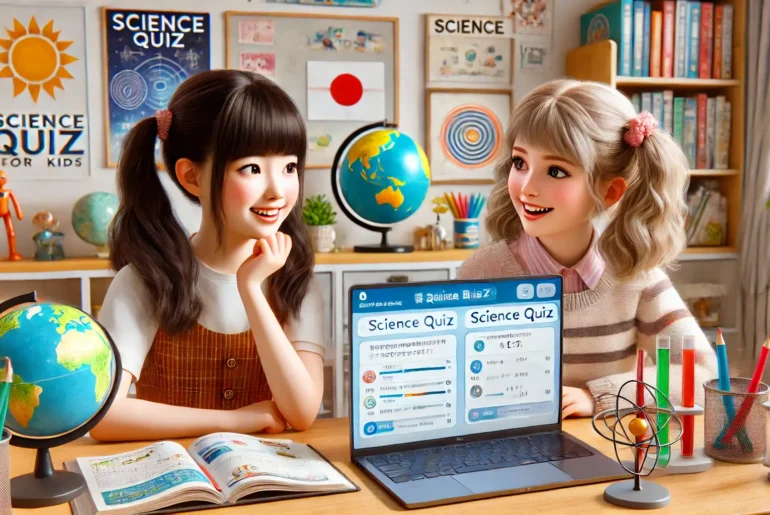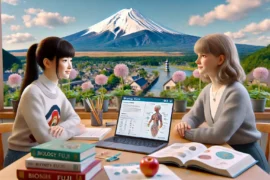Advanced Science Quiz for Kids |
Fun and Challenging Science Quiz for Kids
Introduction
Learning science can be both fun and challenging. It’s a subject full of interesting facts and fascinating phenomena that shape our understanding of the world. This quiz is designed to test your knowledge on various science topics while providing explanations and examples to help you learn even more. Dive into the exciting world of science and see how much you know!
Exploring the Solar System
Our solar system is a vast and intriguing place, home to planets, moons, asteroids, and more. Understanding the basic characteristics of these celestial bodies helps us appreciate the complexity and beauty of the universe.
Example
Did you know that Jupiter is the largest planet in our solar system? It has a diameter of about 142,984 kilometers, making it more than 11 times wider than Earth! Jupiter’s mass is more than twice that of all the other planets in the solar system combined. This giant planet is primarily made of hydrogen and helium and has a Great Red Spot, which is a gigantic storm that has been raging for centuries.
The Wonders of Photosynthesis
Photosynthesis is a crucial process that allows plants to make their own food using sunlight. This process not only sustains plants but also supports life on Earth by producing oxygen.
Example
Plants use photosynthesis to convert sunlight into chemical energy stored in glucose. They take in carbon dioxide from the air and water from the soil, and through a series of chemical reactions powered by sunlight, they produce glucose and oxygen. This process occurs mainly in the leaves, which contain chlorophyll – the pigment that gives leaves their green color.
The Structure of an Atom
Atoms are the building blocks of matter, and understanding their structure is fundamental to science. At the center of an atom is the nucleus, which contains protons and neutrons.
Example
The nucleus of a hydrogen atom consists of just one proton, making it the simplest atom. Other elements have more protons and neutrons in their nuclei. For instance, a carbon atom has six protons and six neutrons. The electrons, which are negatively charged particles, orbit the nucleus at various energy levels.
Essential Gases for Life
Oxygen is essential for the survival of most living organisms. It is a key element in the process of respiration, where cells convert oxygen and glucose into energy, carbon dioxide, and water.
Example
Humans and animals inhale oxygen and exhale carbon dioxide. Plants, on the other hand, take in carbon dioxide and release oxygen during photosynthesis, creating a balance that sustains life on Earth.
The Force of Gravity
Gravity is the force that pulls objects toward the center of the Earth. It keeps us grounded and governs the motion of planets, moons, and other celestial bodies.
Example
Without gravity, we would float off into space. Gravity also causes objects to fall when dropped and gives weight to physical objects. The strength of gravity depends on the mass of the objects and the distance between them.
Chemical Symbols and Compounds
Water, a vital compound for all known forms of life, has the chemical symbol H2O. This symbol represents two hydrogen atoms bonded to one oxygen atom.
Example
Water’s unique properties, such as its ability to dissolve many substances, its high specific heat capacity, and its solid state being less dense than its liquid state, make it essential for life. Ice floats on water, insulating aquatic life during cold periods.
Natural Substances and Hardness
Diamond is the hardest natural substance on Earth. Formed under high pressure and temperature conditions, diamonds are used in cutting tools and jewelry.
Example
Diamonds are made of carbon atoms arranged in a crystal lattice structure. This arrangement gives diamonds their incredible hardness, making them ideal for industrial applications like cutting, grinding, and drilling.
Photosynthesis and Plant Structures
Photosynthesis occurs primarily in the leaves of plants, which contain chlorophyll. This pigment captures sunlight, enabling the plant to convert carbon dioxide and water into glucose.
Example
The process of photosynthesis not only provides food for the plant but also produces oxygen, which is essential for the survival of most living organisms. The leaves’ structure, with their broad surface area and numerous chloroplasts, optimizes the capture of sunlight.
Mars: The Red Planet
Mars is known as the Red Planet due to its reddish appearance, caused by iron oxide (rust) on its surface. This intriguing planet has the largest volcano in the solar system, Olympus Mons.
Example
Mars has a thin atmosphere composed mainly of carbon dioxide. Its surface features include valleys, deserts, and polar ice caps. Scientists are particularly interested in Mars because it has conditions that might have supported life in the past.
The Boiling Point of Water
Water boils at 100 degrees Celsius (212 degrees Fahrenheit) at standard atmospheric pressure. This is a fundamental concept in science that illustrates the transition from liquid to gas.
Example
Boiling water is a common occurrence in daily life, whether cooking or making hot beverages. Understanding the boiling point helps us grasp the principles of heat and phase changes.
Energy in Stretched Rubber Bands
A stretched rubber band stores potential energy, which is released as kinetic energy when the band is let go. This demonstrates the conversion of energy from one form to another.
Example
Potential energy is the energy stored due to an object’s position or state. When the rubber band is released, the stored potential energy is converted into kinetic energy, causing the band to snap back to its original shape.
Proximity to the Sun
Mercury is the closest planet to the sun, with an average distance of about 58 million kilometers. This proximity results in extreme temperature variations on its surface.
Example
During the day, temperatures on Mercury can soar to 430 degrees Celsius (800 degrees Fahrenheit), while at night, they can plummet to -180 degrees Celsius (-290 degrees Fahrenheit). Mercury’s lack of a significant atmosphere contributes to these drastic temperature changes.
Evaporation and Phase Changes
Evaporation is the process by which a liquid changes into a gas. This is a key concept in understanding the water cycle and various natural phenomena.
Example
Water evaporates from oceans, lakes, and rivers, rising into the atmosphere and forming clouds. This process is driven by the sun’s heat and is essential for the distribution of water around the planet.
Genetic Material in Cells
The nucleus of a cell contains genetic material (DNA), which holds the instructions for the cell’s functions and activities. This is the core of cellular biology and genetics.
Example
DNA is organized into chromosomes within the nucleus. It carries the genetic information that determines an organism’s traits and is passed from one generation to the next during reproduction.
Amphibians and Their Life Cycle
Frogs are amphibians, living both in water and on land during different stages of their life cycle. This dual life makes them fascinating subjects for study in biology.
Example
Frogs lay their eggs in water, which hatch into larvae called tadpoles. Tadpoles undergo metamorphosis, developing legs and lungs as they transform into adult frogs that can live on land and in water.
Conclusion
Science is an endlessly fascinating subject that offers countless opportunities for exploration and discovery. By understanding these advanced concepts, kids can develop a deeper appreciation for the natural world and the principles that govern it. Keep asking questions, seeking answers, and enjoying the wonders of science!








Comments are closed.